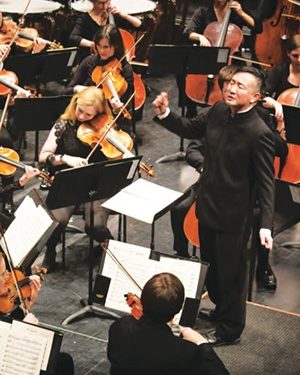This past Saturday, the Illinois Symphony Orchestra performed a program entitled “American Journey” at the UIS Performing Arts Center. The concert was the finale of an enjoyable, if somewhat disappointingly attended, 2021-2022 season, as in-person performance was cautiously reinstated in the wake of the COVID-19 pandemic. This concert will also be the last conducted by departing music director Ken Lam, who has accepted an unspecified position at a “major international music institution” after five seasons leading the ISO. Lam will reportedly continue as “artistic adviser” for the symphony orchestra, and plans are already underway to launch a search for a new music director.
Saturday’s program consisted of works described by Maestro Lam as “three pieces by three iconic composers.” The evening got underway with contemporary Iowa-born composer Michael Daugherty’s brief but impactful musical travelog, “Route 66,” which proved to be fast-paced, jazzy and uniquely percussion-driven. “The percussionists are very happy because they’re not just counting rests, they’re actually playing most of the time,” Lam joked while introducing the piece, also noting that a few ISO musicians had donned earplugs due to the increased sonic wallop.
Internationally renowned guest violinist William Hagen next took the stage for a thrilling rendition of Erich Wolfgang Korngold’s violin concerto, which was first performed in 1947 by the St. Louis Symphony with soloist Jascha Heifetz. Korngold, a Jewish citizen of Vienna, had fatefully accepted a job in California working on the musical score for Errol Flynn’s 1938 film, The Adventures of Robin Hood, when the Nazis invaded Austria. The job likely saved his life. Korngold remained in America and became a naturalized citizen in 1943.
According to Lam, Korngold’s highly dramatic, and cinematic, concerto has rarely been played over the years, largely due to how difficult it is to perform. The Salt Lake City-bred Hagen proved more than equal to the challenge posed by Korngold’s complexity, responding with a fiery and charismatic virtuoso performance. Hagen’s dynamism seemed to egg the ISO musicians to their own collective heights and there were even times when soloist and conductor, bursting with kinetic spirit, seemed almost to break into a spontaneous dance. The rousing climax brought an enraptured audience to its feet.
After a short intermission, the second half of the evening consisted of two pieces by Pennsylvania-born composer Samuel Barber (1910-1981). The melancholy “Adagio for Strings” came first, described as a “national lament” by Lam, who also recalled his first encounter with the composition, in his youth, listening over a car radio. “I was just blown away, it was the most incredible feeling,” he said. “[Barber] just touches you with his writing.”
The evening concluded with Barber’s Symphony No. 1, which Lam described as “arguably the best American symphony” (with possible competition from Copland and/or Bernstein). The approximately 20-minute-long symphony is performed in one movement with four different sections. Characteristic of his enthusiastic and inclusive style, Lam began by walking the audience through elements of the piece, directing specific instrumentalists to demonstrate musical themes, providing uninitiated audience members with a “road map” of Barber’s work. The musicians of the ISO proceeded to give an emotional final performance under the guidance of a conductor and musical director whose earnest, relatable presence and vision have served both these dedicated musicians and their sparse but appreciative audiences very well indeed over the last few uniquely difficult years.
Scott Faingold is Director of Student Media at University of Illinois Springfield as well as co-founder and editor-in-chief of Activator Magazine. He can be reached via [email protected].
Source by www.illinoistimes.com















































